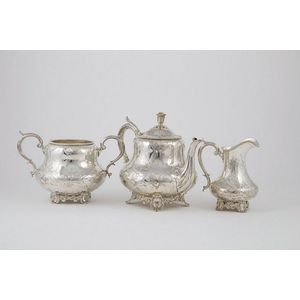Victorian Sterling Silver Tea & Coffee Service with Floral Embossing
You must be a subscriber, and be logged in to view price and dealer details.
Subscribe Now to view actual auction price for this item
When you subscribe, you have the option of setting the currency in which to display prices to $Au, $US, $NZ or Stg.
- Embossed / Repousse - Embossing, also known as repousse, is the technique of decorating metal with raised designs, by pressing or beating out the design from the reverse side of the object.It is the opposite of chasing, where the decoration is applied from the front. An embossed or repoussed object may have chasing applied to finish off the design.
- Sterling Silver - Sterling silver is a mixture of 92.5% pure silver and 7.5% of another metal, usually copper. Fine silver is 99.9% pure silver, and is relatively soft and the addition of the very small amount of copper gives the metal enough strength and hardness to be worked into jewellery, decorative and household objects.
- Victorian Period - The Victorian period of furniture and decorative arts design covers the reign of Queen Victoria from 1837 to 1901. There was not one dominant style of furniture in the Victorian period. Designers used and modified many historical styles such as Gothic, Tudor, Elizabethan, English Rococo, Neoclassical and others, although use of some styles, such as English Rococo and Gothic tended to dominate the furniture manufacture of the period.
The Victorian period was preceded by the Regency and William IV periods, and followed by the Edwardian period, named for Edward VII (1841 ? 1910) who was King of the United Kingdom and the British Dominions and Emperor of India for the brief period from 1901 until his death in 1910. - Acanthus - A stylized leaf motif, one of the primary decorative elements of classical Greek and Roman architecture, derived from the genus of flowering plants in the family Acanthaceae, native to tropical and subtropical regions of the Mediterranean area. It is a common element in classical Greek and Roman design, and is often seen in Corinthian and Composite order columns and used as a decorative element in English, European and Australian furniture, particularly on the curve of a leg, and as decoration for a corbel.
This item has been included into following indexes:
- coffee sets/services - silver items 412
-
tea sets/services
- silver, four piece 301
- silver, Victorian 306
Visually similar items

Victorian sterling silver three piece teaset baluster shape, beaded rims, engraved scrolling decoration and initial on rococo scroll feet, Birmingham, 1861, maker, Thomas Prine & Son

An Indonesian five piece Yogya silver tea service, circa 1930-60s, with marks Zn .800 Delux, comprising a lobed pear shaped tea pot with a foliate 'C' scroll handle, curved spout, and a floriform knop, a matching water pot, a lidded sugar bowl and a small

Fine quality George IV sterling silver four piece tea & coffee set stemmed melon shape, flowerhead finials and floral decorated panels, and acanthus cast handles, London, 1826, maker William Eley

Victorian Scottish sterling silver 3 piece teaset stemmed baluster shape with all-over foliate and scroll engraved decoration, Edinburgh, 1843, maker W.C
